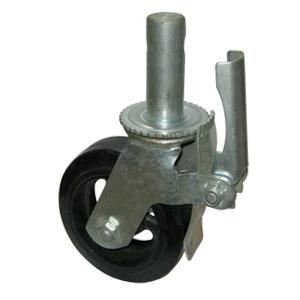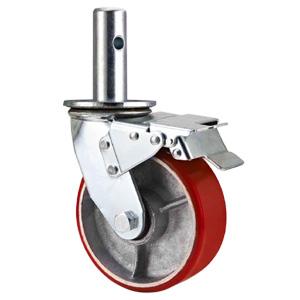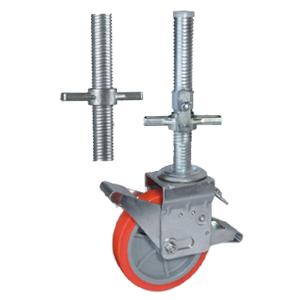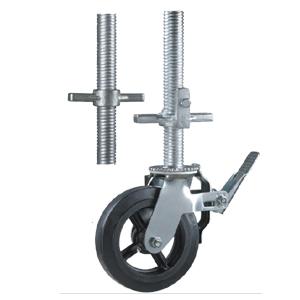Scaffolding Casters And What Makes Them Right
It’s imperative to pick out the correct scaffolding casters to ensure that the work crew does not have any difficulties moving and adjusting the scaffolding. While it is easy to overlook something as small as the scaffold caster wheel that is attached to the bottom of the structure, it is a crucial component of the entire structure, and getting it right is essential. Keep reading to find out more about scaffold caster wheels.
What Is A Scaffolding Caster?
Before we understand what a scaffolding caster is, we need to know what scaffolding is. Scaffolding is a temporary structure, often made of wood and metal, that is found outside buildings, on movie sets, and on other construction sites. The workers of the crew use these scaffoldings to work on the building, which includes cleaning it or even repairing it. The structure is swiftly removed as soon as the site is complete.
Therefore, the scaffolding caster is the small parts attached to the bottom of the scaffolding to help it move around the worksite.
A scaffolding is adjustable and is used by workers to reach different heights in the process of their work. Therefore the scaffold casters allowing it to move should be smooth and easy to roll while also supporting the structure above it.


What Features Make A Scaffolding Caster?
Since the scaffolding is an intricate structure and people need to climb it and move it around for their work, the scaffold caster wheels at the bottom must have specific features that make it the ideal caster for this purpose. Some of the most common features of a scaffolding caster include:
Swivel Mechanism
To make it easy to maneuver the scaffolding around the site, the caster must be able to swivel. The swiveling action makes it easy for the caster to turn and change direction, which means you can take the scaffolding anywhere you want.
Braking And Locking Mechanisms
A caster needs to have an efficient braking mechanism. When workers are on the scaffolding, working on something, the scaffolding will need to stay in one place. If it keeps rolling or swiveling or moving, the workers above it could fall and get injured.
Therefore, most scaffolding casters have an easy-to-access braking mechanism that anyone can easily kick into place to prevent the caster from moving while there is work being done on the scaffolding.
Similarly, it is also essential for scaffolding to have a locking mechanism. Once you have braked the scaffolding and it is in place, you need to ensure that it stays in place and does not start moving on its own. For this purpose, a locking mechanism is necessary to make the scaffolding stay in place while workers are doing tedious jobs above it.
The braking and locking mechanisms are essential to have control over the scaffolding; otherwise, it would easily be displaced and cause injuries to the workers.
Most caster wheels for scaffoldings have steel ball bearings in them. These ball bearings allow for smooth rolling of the wheel and if the wheel starts to tug, you can grease the ball to make it smooth once again.


Load Bearing
A good quality scaffolding caster wheel should be able to carry anywhere between 120-1000 kgs of load. Therefore, on most scaffoldings, multiple workers should be able to work on the construction site at a time. The wheel’s load capacity depends on the size of the scaffolding itself. High-strength polyurethane casters and nylon casters can bear heavy loads without buckling under pressure.
Scaffolding Caster Installation Tips
Since scaffoldings are delicate structures that are intended to carry the weight of multiple workers at a time, it is important to practice safety with the scaffolding casters since they are at the base of the entire structure. To ensure that you install the casters properly, follow these installation tips:
Select Scaffold Casters According To The Flooring
Make sure the casters you choose can roll smoothly on the flooring where your scaffolding will be used. You might want to add some shock-absorbing capacity to the wheels for uneven and rough floors since mishaps can occur otherwise.
Install The Casters First
When setting up scaffolding, make sure that you install the casters before the rest of the structure. This is because you would have to move the entire structure to install the casters otherwise, and it would be a massive inconvenience.
If you set up the base, the casters, first, you will have to build the rest of the structure on top of the base, which would be much easier for the team that is in charge of installations.
Test The Caster
Once you have installed the scaffolding caster wheel in place, you will want to test it out on the floor as well. See if the braking and locking mechanism works properly to avoid mishaps and ensure that the caster rolls smoothly on the floor. Only allow the use of the scaffolding once you are satisfied with how the wheels function.
Scaffolding Caster Safety Measures
If proper caster safety tips are not followed, it is easy to get into accidents and mishaps with scaffoldings. Follow these tips to ensure that you avoid any unwanted events:
● Do not overload the scaffolding. The casters will have to bear the extra load, and they will buckle under the load if it is more than they can handle.
● Do not drop heavy loads on the caster since the initial impact can also cause them to wear down and might also damage the structure.
● Do not roll the scaffolding at high speeds since it can harm people and damage any other obstacles in the way.
● Always lock the scaffold caster wheel in place when the scaffolding does not need to move. If it starts moving when you don’t want it, accidents may occur.
● Make sure you tighten any loose parts of the casters immediately.
Final Thoughts
A scaffolding caster is supposed to be smooth rolling, easy to maneuver, and must stay in place when the workers need it to. It is important to pay attention to the caster when you are first selecting to ensure you get the right thing on the first try. Other than that, you also need to maintain the casters to ensure they remain smooth for a long time.

 English
English Spanish
Spanish German
German Russian
Russian Arabic
Arabic Portuguese
Portuguese Italian
Italian French
French Hebrew
Hebrew Turkish
Turkish